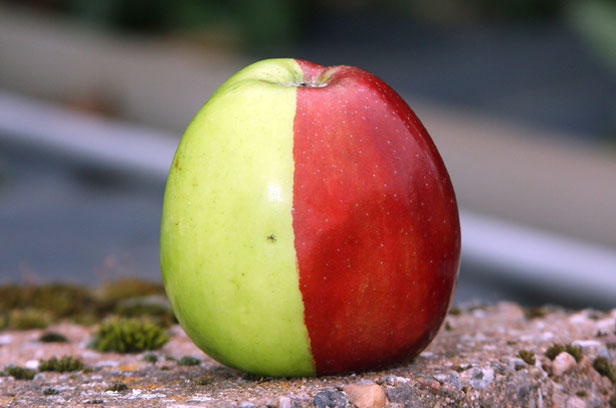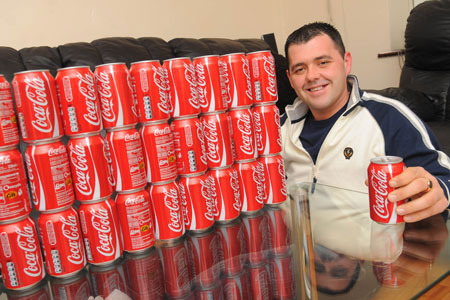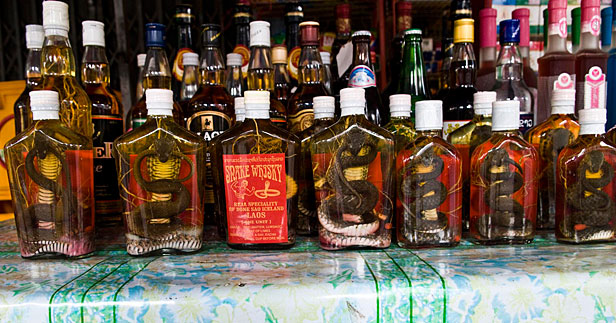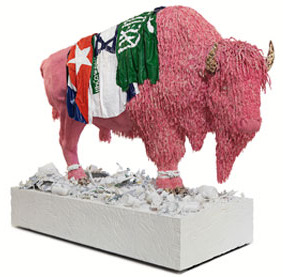Oh, Ripley’s Believe It or Not. Every year, you come out with new tales of bizarre behavior, extreme events, and fantastic fetishes. And despite our best intentions, we can’t ignore you, any more than we can avoid clicking on the latest cute animal video on Huffington Post (Cat adopts baby squirrel? Awww!) No, Ripley’s, not when you clue us in that the average meat-eater consumes 1,200 chickens in a lifetime (“the equivalent of eating a four-year-old elephant”). Or that Eleanor Roosevelt used to snack on three chocolate-covered garlic balls every morning to improve her memory — if not her breath.
These accounts of the fantastic amaze us, of course, but could they also teach us valuable lessons about our food? We’ll bet you a can of cockroaches they can! But don’t take our word for it …
 Photo: Archant Devon 2009 for Ripley’s Believe It or Not
Photo: Archant Devon 2009 for Ripley’s Believe It or Not
If only it showed Jesus, too: This half-red, half-green Golden Delicious apple was grown in England by retired painter Ken Morrish, says page 189. The coloration is believed to be the result of a random genetic mutation with a million-to-one chance of occurring.
Ridiculous Food Lesson #1: Where would we be without genetic biodiversity in our diets? Living in a world with boring apples, that’s where!
 Photo: This is South WalesCokehead: Jason Morgan, a British truck driver from Neath, South Wales, used to drink the equivalent of 26 cans of Coca-Cola every day (page 184). That’s a lot of “corn sugar.” The 5’11” Morgan then lost 119 pounds in 8 months just by quitting his Coke habit.
Photo: This is South WalesCokehead: Jason Morgan, a British truck driver from Neath, South Wales, used to drink the equivalent of 26 cans of Coca-Cola every day (page 184). That’s a lot of “corn sugar.” The 5’11” Morgan then lost 119 pounds in 8 months just by quitting his Coke habit.
Ridiculous Food Lesson #2: Michael Pollan’s food rules have taught us to to recognize sugar (and other sweeteners) by every other name, especially when it’s in the top three ingredients. Caught you, “high-fructose corn syrup now known as corn sugar”! Also, have we mentioned excessive soda pop is the rotten-toothed, diabetic devil? We’re shocked that Morgan has anything left to smile with.
 Photo: Ripley’s Believe It or Not
Photo: Ripley’s Believe It or Not
Gelatin giants: Derek Lawson makes 5-pound gummi bears at Popalop’s Candy Shop in Raleigh, N.C., that are 1,400 times the size of an ordinary gummi bear (page 189).
Ridiculous Food Lesson #3: The gummy part of these gummi bears is made from gelatin, which is produced by boiling down the connective tissue, bones, and skins of animals, usually cows and pigs. Although the industry says that this process is enough to destroy any of the nasty mad-cow-disease-carrying prions, we’d avoid the super-sized helpings.
 Photo: Ripley’s Believe It or Not
Photo: Ripley’s Believe It or Not
Deadly medicine: Got arthritis, fever, or whooping cough? Laotian sufferers might pick up a bottle of snake wine — which has a real dead snake inside. The poison of venomous snakes is dissolved in the liquor, which is then used to treat a range of ailments.
Ridiculous Food Lesson #4: As Dr. Daphne Miller writes in The Jungle Effect, there are a lot of healthful aspects of so-called native diets that we don’t understand. However, if you down too much snake wine, be aware you might make an asp of yourself.
 Photo: Fiji TimesThis omnivore has no dilemma: Since he was 10, Rakesh “Cobra” Narayan of Moala, Fiji, has consumed just about everthing — including shoes, fluorescent tubes, pieces of concrete, and even a lawn mower. He claims to have never suffered any ill effects.
Photo: Fiji TimesThis omnivore has no dilemma: Since he was 10, Rakesh “Cobra” Narayan of Moala, Fiji, has consumed just about everthing — including shoes, fluorescent tubes, pieces of concrete, and even a lawn mower. He claims to have never suffered any ill effects.
Ridiculous Food Lesson #5: This is one way to send less waste to the landfill. And spend less money on food.
 Photo: Pastificio Cerere FoundationSpitting images: Maurizio Savini creates sculptures using only thousands of pieces of chewed bubblegum, including a pink life-size buffalo. His pieces have sold for as much as $65,000 each.
Photo: Pastificio Cerere FoundationSpitting images: Maurizio Savini creates sculptures using only thousands of pieces of chewed bubblegum, including a pink life-size buffalo. His pieces have sold for as much as $65,000 each.
Ridiculous Food Lesson #6: It’s better to sculpt than swallow. The all-knowing Wikipedia says there is no truth the old wives’ tale that gum is indigestible and will lodge in your appendix. But it also says that chewing gum is made of chicle, a natural latex product, or of the same synthetic rubber used for inner tubes. Now that sounds lip-smacking good.


